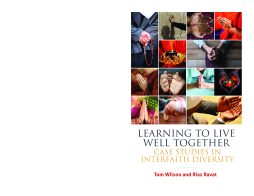
Additional Information
Book Details
Abstract
In modern multi-faith societies, religious diversity not only affects religious organisations and communities, but indeed every aspect of life. From celebrating cultural events, to considering how the police should interact with members of the public from different faith communities, this book highlights the ways in which all members of society can engage constructively with diversity.
This ground-breaking book draws on the work at the St Philip's Centre in Leicester and presents a collection of case studies to show how people from a variety of religious backgrounds and ethical convictions have learnt to coexist peacefully. Without shying away from the conflicts and challenges that have occurred, the book focuses on the lessons learnt and offers real examples of how to promote positive interfaith relationships.
This is an excellent resource for anyone wishing to understand the issues of religion and belief that may arise at local and national levels, and develop appropriate attitudes and actions for peaceful resolution.
Even before moving to Leicester, I had heard much talk of the 'Leicester model' of social cohesion. As this book makes clear, there is much that is unique about Leicester, but also much that this wonderful city can teach us about one of the defining questions of our time: how we can learn to live well together.
The Rt Revd Martyn Snow, Bishop of Leicester
Tom Wilson is director of the St Philip's Centre in Leicester, which provides training and consultancy on interfaith and multifaith issues for a wide range of local and national bodies, including the Home Office, schools, the city council, and the police.
Riaz Ravat BEM is Deputy Director of the St Philip's Centre.
Learning to live well together is vitally important in over-coming prejudice, in healing society's divisions and reducing the dangers of extremism... The [St Philip's] Centre is, as I know from some personal knowledge of its activities, doing excellent work. Leaders of local interfaith groups, many of which are doing similar important work, will be helped by reading it [Learning to Live Well Together].
The Alister Hardy Trust, De Numine
I urge all to read this book and learn from Tom Wilson's and Riaz Ravat's exciting work in Leicester. This excellent book will develop your understanding of living and integrating in a multicultural society that the UK so clearly is today.
Colonel Stuart Williams, 7th Infantry Brigade, The Desert Rats
Learning to Live Well Together gives real world examples of how individuals and communities can build safer, stronger and happier lives by engaging in dialogue, interaction and in the development of social connections that ensure more resilient communities. Today, the global challenges have grown and ensuring that people and communities can weather some of the winds that buffet us, is key. This book highlights these practical and real world examples and therefore can also inspire many to be the 'forces for good' that this country continuously needs.
Fiyaz Mughal, Founder and Director, Faith Matters, Founder – Tell MAMA
An Unexpected Treasure... Perhaps no community in the world has generated the kind of transforming interfaith dialogue with measurable results that Leicester is experiencing. During and after the Brexit vote, hate crimes doubled in Leicester; but they multiplied five-fold in the rest of the country. This well-documented and indexed 178-page narrative sheds light on how and why Leicester did so much better. The book is a clear candidate for best interfaith book of 2017...
This is a pioneering book that sets our assumptions topsy-turvy, makes us rethink the whole process of dialogue with 'the other,' and offers directions for a peaceful world in spite of all the conflict we face today. It is an invaluable resource for interfaith activists. With this kind of approach, the possibilities of an authentic, effective interfaith movement become brighter. Co-authors Tom Wilson, director of St. Philip's Centre, and Riaz Ravat, deputy director, have done their homework and leave us with tools to empower any interfaith activist.
The Interfaith Observer
Undoubtedly a well-researched, highly readable book. It highlights the importance of living well and working together for the shared common good through mutual understanding of the traditions, teachings and practices of diverse communities. The book presents the St Philip's Centre's positive approach to community cohesion and inter-faith issues.
Councillor Manjula Sood, Chair, Leicester Council of Faiths
Modern Britain is diverse and this is an exemplar of imaginative interfaith work from Leicester. Now with much experience of changing contexts, the authors maturely celebrate what is possible whilst addressing the hard challenges. Here we see some next steps to try out as we attempt living well together.
The Very Revd David Monteith, Dean of Leicester
Table of Contents
| Section Title | Page | Action | Price |
|---|---|---|---|
| Learning to Live Well Together: Case Studies in Interfaith Diversity - Tom Wilson and Riaz Ravat | 5 | ||
| Acknowledgements | 9 | ||
| Introduction | 11 | ||
| 1. The Leicester Context - Tom Wilson and Riaz Ravat | 15 | ||
| 2. The St Philip’s Centre - Tom Wilson and Riaz Ravat | 27 | ||
| 3. Encounter - Tom Wilson | 49 | ||
| 4. Understand - Tom Wilson | 79 | ||
| 5. Trust - Tom Wilson | 103 | ||
| 6. Co-operate - Tom Wilson | 125 | ||
| 7. Interfaith in the Twenty-First Century by Riaz Ravat | 139 | ||
| 8. Where Next? - Tom Wilson | 149 | ||
| References | 159 | ||
| Subject Index | 169 | ||
| Author Index | 175 | ||
| Blank Page |
